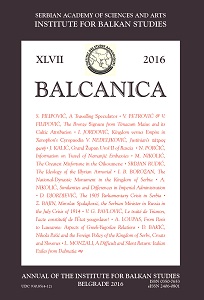Grand Župan Uroš II of Rascia
Grand Župan Uroš II of Rascia
Author(s): Jovanka KalićSubject(s): History
Published by: Balkanološki institut - Srpska akademija nauka i umetnosti
Keywords: archžupan/magnus comes; Serbia; Rascia; city of Ras (Novi Pazar); Uroš II; Byzantium;Hungary in 15 th century;
Summary/Abstract: Historical data on the person and policies of the “veliki [grand] župan” Uroš II – archžupan in Byzantine sources, magnus comes in Latin texts – can be found in twelfth-century Serbian, Greek, Hungarian, German and Russian sources. The paper is divided into three sections dealing specifically with Uroš II’s family relations (ancestors and descendants); chronological issues of his reign in Serbia; and his domestic and foreign policies. Uroš II’s father, the Serbian župan Uroš I, had three sons and a daughter: Uroš II, Desa, Beloš and Helen (Jelena). Uroš II succeeded his father as the ruler of Serbia. Helen married king Béla II of Hungary (1131–41) and became a very influential figure at the Hungarian court. Their brother Beloš, who was known in Hungary as ban Béla and subsequently held the office of the palatine of Hungary, considerably contributed to the firming up of Serbian-Hungarian political ties. Based on a detailed analysis of the surviving sources, the author suggests the conclusion that Uroš II was a true predecessor of Stefan Nemanja in all his policies. He was a vassal of the Byzantine emperor but he allied with Hungary in the aspiration to achieve independence. At the time of Uroš II and his successors the region of Rascia (Raška, Rassa), known for the city of Ras (modern Novi Pazar) and the Bishopric of Raška with the bishop’s seat at the church of Sts Peter and Paul, was the core of the Serbian state.
Journal: BALCANICA
- Issue Year: 2016
- Issue No: 47
- Page Range: 75-96
- Page Count: 23
- Language: English

